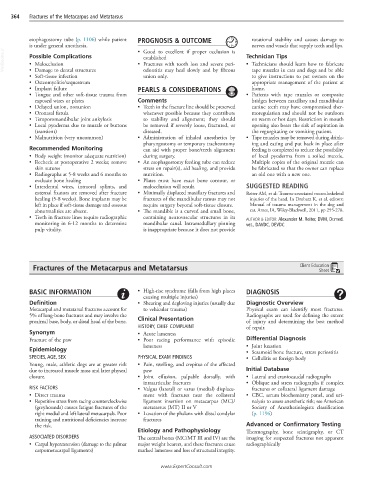Page 770 - Cote clinical veterinary advisor dogs and cats 4th
P. 770
364 Fractures of the Metacarpus and Metatarsus
esophagostomy tube (p. 1106) while patient PROGNOSIS & OUTCOME rotational stability and causes damage to
is under general anesthesia. • Good to excellent if proper occlusion is nerves and vessels that supply teeth and lips.
VetBooks.ir Possible Complications • Fractures with tooth loss and severe peri- Technician Tips
established
• Technicians should learn how to fabricate
• Malocclusion
• Damage to dental structures
union only.
to give instructions to pet owners on the
• Soft-tissue infection odontitis may heal slowly and by fibrous tape muzzles in cats and dogs and be able
• Osteomyelitis/sequestrum appropriate management of the patient at
• Implant failure PEARLS & CONSIDERATIONS home.
• Tongue and other soft-tissue trauma from • Patients with tape muzzles or composite
exposed wires or plates Comments bridges between maxillary and mandibular
• Delayed union, nonunion • Teeth in the fracture line should be preserved canine teeth may have compromised ther-
• Oronasal fistula whenever possible because they contribute moregulation and should not be outdoors
• Temporomandibular joint ankylosis to stability and alignment; they should on warm or hot days. Restriction in mouth
• Local pyoderma due to muzzle or buttons be removed if severely loose, fractured, or opening also bears the risk of aspiration in
(transient) diseased. the regurgitating or vomiting patient.
• Malnutrition (very uncommon) • Administration of inhaled anesthetics by • Tape muzzles may be removed during drink-
pharyngostomy or temporary tracheostomy ing and eating and put back in place after
Recommended Monitoring can aid with proper bone/teeth alignment feeding is completed to reduce the possibility
• Body weight (monitor adequate nutrition) during surgery. of local pyoderma from a soiled muzzle.
• Recheck at postoperative 2 weeks; remove • An esophagostomy feeding tube can reduce Multiple copies of the original muzzle can
skin sutures stress on repair(s), aid healing, and provide be fabricated so that the owner can replace
• Radiographs at 5-8 weeks and 6 months to nutrition. an old one with a new one.
evaluate bone healing • Plates must have exact bone contour, or
• Interdental wires, intraoral splints, and malocclusion will result. SUGGESTED READING
external fixators are removed after fracture • Minimally displaced maxillary fractures and Reiter AM, et al: Trauma-associated musculoskeletal
healing (5-8 weeks). Bone implants may be fractures of the mandibular ramus may not injuries of the head. In Drobatz K, et al, editors:
left in place if soft-tissue damage and osseous require surgery beyond soft-tissue closure. Manual of trauma management in the dog and
abnormalities are absent. • The mandible is a curved and small bone, cat. Ames, IA, Wiley-Blackwell, 2011, pp 255-278.
• Teeth in fracture lines require radiographic containing neurovascular structures in its AUTHOR & EDITOR: Alexander M. Reiter, DVM, Dr.med.
monitoring in 6-12 months to determine mandibular canal. Intramedullary pinning vet., DAVDC, DEVDC
pulp vitality. is inappropriate because it does not provide
Fractures of the Metacarpus and Metatarsus Client Education
Sheet
BASIC INFORMATION • High-rise syndrome (falls from high places DIAGNOSIS
causing multiple injuries)
Definition • Shearing and degloving injuries (usually due Diagnostic Overview
Metacarpal and metatarsal fractures account for to vehicular trauma) Physical exam can identify most fractures.
5% of long-bone fractures and may involve the Clinical Presentation Radiographs are used for defining the extent
proximal base, body, or distal head of the bone. of injury and determining the best method
HISTORY, CHIEF COMPLAINT of repair.
Synonym • Acute lameness
Fracture of the paw • Poor racing performance with episodic Differential Diagnosis
lameness • Joint luxation
Epidemiology • Sesamoid bone fracture, stress periostitis
SPECIES, AGE, SEX PHYSICAL EXAM FINDINGS • Cellulitis or foreign body
Young, male, athletic dogs are at greater risk • Pain, swelling, and crepitus of the affected
due to increased muscle mass and later physeal paw Initial Database
closure. • Joint effusion, palpable dorsally, with • Lateral and craniocaudal radiographs
intraarticular fractures • Oblique and stress radiographs if complex
RISK FACTORS • Valgus (lateral) or varus (medial) displace- fractures or collateral ligament damage
• Direct trauma ment with fractures near the collateral • CBC, serum biochemistry panel, and uri-
• Repetitive stress from racing counterclockwise ligament insertion on metacarpus (MC)/ nalysis to assess anesthetic risk; see American
(greyhounds) causes fatigue fractures of the metatarsus (MT) II or V Society of Anesthesiologists classification
right medial and left lateral metacarpals. Poor • Luxation of the phalanx with distal condylar (p. 1196)
training and nutritional deficiencies increase fractures
the risk. Advanced or Confirmatory Testing
Etiology and Pathophysiology Thermography, bone scintigraphy, or CT
ASSOCIATED DISORDERS The central bones (MC/MT III and IV) are the imaging for suspected fractures not apparent
• Carpal hyperextension (damage to the palmar major weight bearers, and these fractures cause radiographically
carpometacarpal ligaments) marked lameness and loss of structural integrity.
www.ExpertConsult.com

